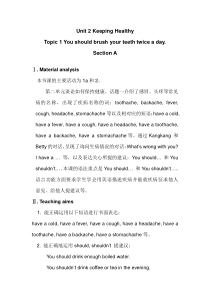 DOC
DOC
【文档说明】《Unit 2 Topic 1 You should brush your teeth twice a day》教学设计1-八年级上册英语仁爱(科普版).doc,共(6)页,38.000 KB,由小喜鸽上传
转载请保留链接:https://www.ichengzhen.cn/view-104944.html
以下为本文档部分文字说明:
Unit2KeepingHealthyTopic1Youshouldbrushyourteethtwiceaday.SectionAⅠ.Materialanalysis本节课的主要活动为1a和2。第二单元谈论如何
保持健康。话题一介绍了感冒、头疼等常见病的名称,出现了疾病名称的词:toothache,backache,fever,cough,headache,stomachache等以及相对应的短语:haveacold,haveafever
,haveacough,haveaheadache,haveatoothache,haveabackache,haveastomachache等。通过Kangkang和Betty的对话,呈现了询问生病情况的对话:What’swrongwithyou?Ihavea…等,以及表达
关心所提的建议:Youshould…和Youshouldn’t…。本课的语法重点是Youshould…和Youshouldn’t…。语言功能方面要求学生学会用英语描述疾病并能就疾病征求他人意见、给他人提建
议等。Ⅱ.Teachingaims1.能正确运用以下短语进行书面表达:haveacold,haveafever,haveacough,haveaheadache,haveatoothache,haveabackache,haveastomachach
e等。2.能正确地运用should,shouldn’t提建议:Youshoulddrinkenoughboiledwater.Youshouldn’tdrinkcoffeeorteaintheevening.Skillaims:1
.能听懂有关日常小病的名称及相关话题。2.能熟练地运用should,shouldn’t针对日常小病提建议。3.能正确朗读介绍日常小病的对话或文章。4.能用should,shouldn’t结合本单元短语描
述日常生活小病并提出有益的建议。Emotionalaims:通过语言学习,影响学生的自身品格,要学会信任他人、关心他人,为我们的健康生活创建友爱、和谐的氛围。Ⅲ.ThekeypointsanddifficultpointsKeypoints:haveacold,haveafe
ver,haveacough,haveaheadache,haveatoothache,haveabackache,haveastomachache等短语的理解及运用。Difficultpoints:就日常小病用英语提建议。Ⅳ.Le
arningstrategies1.培养学生根据图片猜单词意思的能力。2.培养学生模仿已有例句造句的能力。Ⅴ.TeachingaidsComputermultimediaprojector,picturesofdifferentillnessesEver
ydaysaying:Bitterpillsmayhavewholesomeeffects.良药苦口利于病。Ⅵ.TeachingproceduresStep1.Lead-in:(Thesong:BrushYourTeeth)1.Stude
ntsandteacherSingthesongandfollowittogether.2.Letstudentsanswerthetwoquestions:T:Doyoubrushyourteeth?T:Howoftendoyoubru
shyourteeth?Step2Presentation1.Teacherpresentssomepicturesaboutthenewwords:cold,fever,cough,headache,backacheandstomachache.newphrases:haveacold/
fever/cough/headache/backache/toothachestomachache2.Finishthetableaboutillness.3.呈现1c图片.Listenandnumberthepictures,andthecheckt
heanswers.4.Teacherasksandanswersabout“haveafever”asamodelforthestudentstoimitate.T:What’sthematter?Ss:Hehasa...5.Pairwork:Studentsaskanda
nswerinpairs,using“haveacough”,“haveaheadache”,and“haveatoothache”…6.Playagame:ActandGuess.Step3Consolidation1.Letstudentswatchtheflashof1a
,readafteritandthetranslatethesentencesonebyone.2.Read1aingroups.3.Playagame:Two-manact.Ask2-3groupstoact
itout.4.Letstudentstrytorememberthekeypointsin1a.1)What’swrongwithyou?=What’sthematterwithyou?2)should/shouldn’t+动词原形应该/不应该Step4SummaryStudentssumma
rizeSectionAwiththeteacherbydoingexercisesshownonthescreen.Step5.ExerciseStep6.HomeworkT:Makeasurvey.Researchsomeclassmateswhohad
aillnessinthelasttime。Thengiveareportinnextclass.教学反思:1、在设计教学的过程中,努力贯彻以学生为主体的教学新理念,注意调动学生学习的积极性和主动参与的感情,整合教材,设计的活动符合学生的年龄特
点。鼓励和引导学生积极发言,力求各个活动环环相扣,以符合学生的思维特点和认知水平。2、通过创设各种问题情境,吸引学生的注意力,营造宽松愉悦的学习气氛,特别之处在于探究活动的过程中,设置一些问题启发学生思考、讨论,有效地突破教学难点。本节课还有一些需要改进之处:1、时间分配需要更合理。由
于引入和练习环节稍超出预设范围,为使教学时间不超时,在后面讨论环节,未能让更多学生畅谈,深感遗憾。2、在教学过程中,语度有些快,影响学生的理解,所以我在今后的教学中,应注意这些细节的处理。板书设计:Unit2KeepingHealthyTopic1Youshouldbrushyourte
ethtwiceaday.SectionAKeyPhrases:KeySentences:toothache1.What’swrongwith...?cold2.What’sthematterwith...fever3.Yousho
uld...haveacough4.Youshouldn’t...headachebackachestomachache
 辽公网安备 21102102000191号
辽公网安备 21102102000191号
 营业执照
营业执照